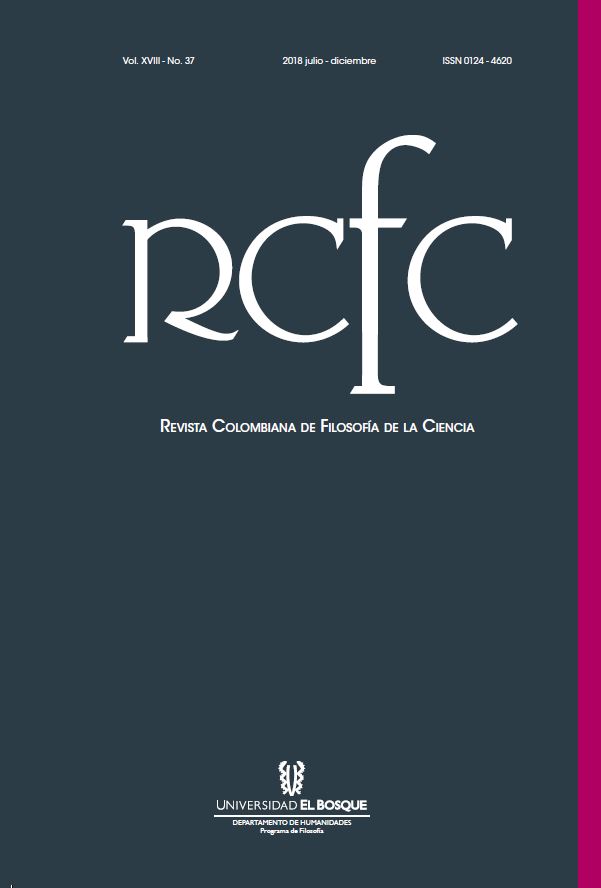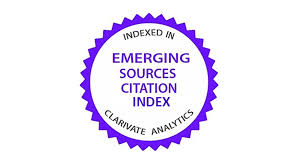Historizar la objetividad
la matematización y automatización de la sistemática molecular en la reconstrucción de la historia de la vida
DOI:
https://doi.org/10.18270/rcfc.v18i37.2578Palabras clave:
Objetividad, Objetividad, sistemática;, sistemática;, filogenias, filogenias, computadoras, computadoras, estadística, estadística, algoritmos, algoritmosResumen
En este artículo defendemos un punto de vista historicista respecto a la relación entre historia y filosofía de la ciencia. En particular, argumentamos que el problema filosófico de la objetividad de las prácticas científicas debe ser guiado por el estudio detallado del contexto de los problemas y las prácticas de investigación de cada campo o disciplina particular. Para ello, nos enfocamos en el proceso de matematización de los criterios y decisiones en la sistemática, ocurrido a partir de la década de 1960, cuyo objetivo ha sido la elaboración de reconstrucciones objetivas de las relaciones filogenéticas entre seres vivos; estas prácticas también pueden formularse como una “eliminación de la subjetividad”, posible gracias a la molecularización del estudio de la evolución biológica y la introducción de bases de datos masivas de secuencias de proteínas y ácidos nucleicos, así como el uso de computadoras y algoritmos matemáticos. La atención a disputas filosóficas entre cladistas, evolucionistas y feneticistas ha obstaculizado la producción de narrativas históricas centradas en prácticas, y la reflexión epistemológica fructífera sobre el tema de la objetividad en el trabajo científico.
Descargas
Referencias bibliográficas
Abascal, F., R. Zardoya, y D. Posada. “ProtTest: selection of best-fit models of protein evolution”. Bioinformatics 21.9 (2005): 2104-2105. <https://doi.org/10.1093/bioinformatics/bti263>.
Anaya, V., y Suárez, E. s/f. “Subjectivity through the main door: The success of Bayesian methods in the reconstruction of molecular phylogenies”. En prensa.
Daston, L., y Galison, P. “The Image of Objectivity”. Representations 40 (1992): 81–128.
_______. Objectivity. New York: Zone Books, 2007. <https://mitpress.mit.edu/books/objectivity>.
Dayhoff, M. O. Atlas of Gene Sequence and Structure. Vol. 4. National Biomedical Research Fundation, 1969.
De Chadarevian, S. “Protein Sequencing and the Making of Molecular Genetics”. Trends in Biochemical Sciences 24.5 (1999): 203–206. <https://doi.org/10.1016/S0968-0004(99)01360-2>.
_______. Designs for Life: Molecular Biology after World War II. Cambridge, MA: Cambridge University Press, 2002.
De Chadarevian, S. y Harmke, K. Molecularizing Biology and Medicine: New Practices and Alliances, 1920s to 1970s. Australia: Harwood Academic Publishers, 1998.
Eck, R. V., y Margaret O. D. Atlas of Protein Sequence and Structure. Silver Spring, Maryland: National Biomedical Research Foundation, 1966.
Edgar, R. C. “MUSCLE: Multiple Sequence Alignment with High Accuracy and High Throughput.” Nucleic Acids Research 32.5 (2004): 1792–1797. <https://doi.org/10.1093/nar/gkh340>.
Felsenstein, J. “Statistical Inference and Estimation of Phylogenies”.Ph.D. Thesis. University of Chicago, 1968.
_______. “The Troubled Growth of Statistical Phylogenetics”. Systematic Biology 50.4 (2001): 465–467.
Fitch, W. M. “Homology: a personal view on some of the problems”. Trends in Genetics 16.5 (2000): 227–231. <https://doi.org/10.1016/S0168-9525(00)02005-9>.
Fitch, W. M., y Emanuel M. “Construction of Phylogenetic Trees”. Science 155.3760 (1967):279–284. <https://doi.org/10.1126/science.155.3760.279>.
García-Sancho, M. “A New Insight into Sanger’s Development of Sequencing: From Proteins to DNA, 1943-1977”. Journal of the History of Biology 43.2 (2010): 265–323. <https://doi.org/10.1007/s10739-009-9184-1>.
Gigerenzer, G., Zeno S., Theodore, P., Lorraine, D., John, B., y Lorenz, K. The Empire of Chance: How Probability Changed Science and Everyday Life. Cambridge: Cambridge University Press, 1989. <https://doi.org/10.1017/CBO9780511720482>.
Hagen, J. B. “Naturalists, Molecular Biologists, and the Challenges of Molecular Evolution”. Journal of the History of Biology 32.2 (1999): 321–341.
_______. “The Introduction of Computers into Systematic Research in the United States during the 1960s”. Studies in the History and Philosophy of Biological and Biomedical Sciences 32 (2001): 291–314.
_______. “The Statistical Frame of Mind in Systematic Biology from Quantitative Zoology to Biometry”. Journal of the History of Biology 36.2 (2003): 353–384.
Harmon, L. J. “Dechronization Interviews Joe Felsenstein”. Consultado el 10 de octubre de 2017.http://treethinkers.blogspot.com/2009/04/dechronization-interviews-joe.html.
Hull, D. L. Science as a Process: An Evolutionary Account of the Social and Conceptual Development of Science. University of Chicago Press, 1988.
Katoh, K., y D. M. Standley. “MAFFT Multiple Sequence Alignment Software Version 7: Improvements in Performance and Usability.” Molecular Biology and Evolution 30.4 (2013): 772–780. <https://doi.org/10.1093/molbev/mst010>.
Larkin, M. A., G. Blackshields, N. P. Brown, R. Chenna, P. A. McGettigan, H. McWilliam, F. Valentin, et al. “Clustal W and Clustal X Version 2.0”. Bioinformatics 23.21 (2007): 2947–48. <https://doi.org/10.1093/bioinformatics/btm404>.
Lenoir, T. “Shaping Biomedicine as an Information Science”. Proceedings of the 1998 Conference on the History and Heritage of Science Information Systems. Eds. Bowden, M. E. Trudi, B. y Robert W. Medford. New Jersey: ASIS Monograph Series, Information Today, 1999. 27–45 <http://webdoc.sub.gwdg.de/ebook/a/2001/asisbook.pdf#page=39>.
Leonelli, S. “Introduction: Making Sense of Data-Driven Research in the Biological and Biomedical Sciences”. Studies in History and Philosophy of Biological and Biomedical Sciences 43.1 (2012): 1–3. https://doi.org/10.1016/j.shpsc.2011.10.001.
Margoliash, E. “Primary Structure and Evolution of Cytochrome C”. Proceedings of the National Academy of Sciences 50.4 (1963): 672–679.
Nagel, T. The View from Nowhere. New York: Oxford University Press, 1989. https://global.oup.com/academic/product/the-view-from-nowhere-780195056440.
Notredame, C., D. G. Higgins, y J. Heringa. “T-Coffee: A Novel Method for Fast and Accurate Multiple Sequence Alignment”. Journal of Molecular Biology 302.1 (2000): 205–217.< https://doi.org/10.1006/jmbi.2000.4042>.
November, J. A. Biomedical Computing: Digitizing Life in the United States. The Johns Hopkins University Press, 2012. <https://muse.jhu.edu/book/14634>.
Pickstone, J. “Ways of Knowing: Towards a Historical Sociology of Science, Technology and Medicine”. The British Journal for the History of Science 26.4 (1993): 4433.
Porter, T. “Quantification and the accounting ideal in science”. Social studies of science 22.4 (1992):633–651.
_______. Trust in Numbers: The Pursuit of Objectivity in Science and Public Life. New Jersey: Princeton University Press, 1995. <https://www.jstor.org/stable/j.ctt7sp8x>.
Simpson, G. G. “The Meaning of Taxonomic Statements”. Classification and Human Evolution. Ed. Sherwood I. Washburn. London: Methuen and Co. Ltd, 1964. 1–31.
Sober, E. Reconstructing the Past. Parsimony, Evolution, and Inference. MIT Pres, 1988.
Sokal, R. R., y Peter, H. A. S. The Principles of Numerical Taxonomy. London: W.H. Freeman & Co., 1963.< http://www.jstor.org/stable/1217562>.
Sterner, B, y Scott L. “Moving Past the Systematics Wars”. Journal of the History of Biology 51.1 (2017): 31-67. <https://doi.org/10.1007/s10739-017-9471-1>.
Strasser, B. J. “Collecting, Comparing, and Computing Sequences: The Making of Margaret O. Dayhoff’s Atlas of Protein Sequence and Structure, 1954-1965”. Journal of the History of Biology 43.4 (2010): 623–660. <https://doi.org/10.1007/s10739-009-9221-0>.
Suárez, Edna, y Víctor Hugo Anaya. “History, Objectivity, and the Construction of Molecular Phylogenies”. Studies in History and Philosophy of Science Part C: Studies in History and Philosophy of Biological and Biomedical Sciences 39.4 (2008): 451–468.
_______. “La ansiedad metodológica como búsqueda de objetividad: La construcción de filogenias moleculares”. Ludus Vitalis 17.31 (2009): 33–64.
Suárez-Díaz, Edna. “The Long and Winding Road of Molecular Data in Phylogenetic Analysis”. Journal of the History of Biology 47.3 (2014): 443–478.
_______. “The Molecular Basis of Evolution and Disease: A Cold War Alliance”. Journal of the History of Biology (2017): 1-28. <https://doi.org/10.1007/s10739-017-9476-9>.
Zuckerkandl, Emile. “Perspectives in Molecular Anthropology”. Classification and Human Evolution. Ed. Sherwood I. Washburn. London: Methuen and Co. Limited, 1964.
Zuckerkandl, E., y L. Pauling. “Molecules as Documents of Evolutionary History”. Journal of Theoretical Biology 8.2 (1965): 357–366.
Zuckerkandl, Emile, y Linus Pauling. “Molecular Disease, Evolution and Genic Heterogeneity”. Horizons in Biochemistry: Albert Szent-Györyi Dedicatory Volume. Eds. M Kasha y B Pullman. New York: Academic Press, 1962. 189–225.
Descargas
Publicado
Cómo citar
Número
Sección

| Estadísticas de artículo | |
|---|---|
| Vistas de resúmenes | |
| Vistas de PDF | |
| Descargas de PDF | |
| Vistas de HTML | |
| Otras vistas | |











